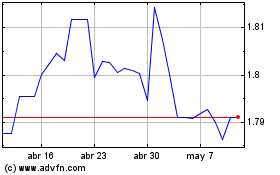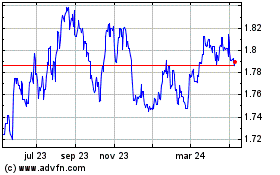Euro Higher After Eurozone Inflation Hits 5-1/2-year High
31 Julio 2018 - 1:35AM
RTTF2
The euro was higher against its most major counterparts in the
European session on Tuesday, following a data showing an
acceleration in the euro area inflation in July to its highest
since December 2012.
Preliminary data from Eurostat showed that the harmonized index
of consumer prices rose 2.1 percent year-on-year in July, after
climbing 2 percent in June. Economists had expected the rate to
remain unchanged.
Core inflation, excluding energy, food, alcohol and tobacco,
accelerated to 1.1 percent in July from 0.9 percent in June.
Economists had expected an increase to 1 percent.
The core figure was 1.1 percent in May.
Meanwhile, separate data showed that the euro area economy grew
at a slower pace in the second quarter.
Gross domestic product grew 0.3 percent from the first quarter,
when the economy expanded 0.4 percent. A similar slower growth was
last seen in the second quarter of 2016.
European shares were mixed as investors digested the latest
batch of earnings and mixed economic reports.
The Federal Reserve's monetary policy announcement is due on
Wednesday, with traders likely to keep a close eye on the
accompanying statement for clues about the outlook for rates.
The Bank of England is widely expected to increase rates by a
quarter point when it concludes its policy meeting on Thursday.
The currency traded mixed against its major counterparts in the
Asian session. While it held steady against the greenback and the
pound, it fell against the franc. Against the yen, it rose.
The single currency hovered at a 5-day high of 1.1731 against
the greenback, compared to 1.1705 hit late New York Monday. If the
euro rises further, 1.19 is likely seen as its next resistance
level.
The 19-nation currency appreciated to 130.85 against the
Japanese yen, its strongest since July 20. The euro is seen finding
resistance around the 132.00 mark.
The Bank of Japan retained its massive monetary stimulus and
announced its plan to bring flexibility in bond operations.
The bank said it intends to maintain the current extremely low
levels of short and long-term interest rates for an extended period
of time.
Having fallen to near a 4-week low of 1.1561 against the Swiss
franc at 9:15 pm ET, the euro reversed direction and climbed to
1.1589. On the upside, 1.18 is possibly seen as the next resistance
level for the euro.
The euro appreciated to a weekly high of 1.7209 against the
kiwi, from a low of 1.7137 hit at 8:30 pm ET. The next possible
resistance for the euro is seen around the 1.73 level.
The euro bounced off to 1.5806 against the aussie, from a low of
1.5758 seen at 1:45 am ET. The euro is poised to locate resistance
around the 1.60 level.
Data from the Australian Bureau of Statistics showed that
Australia's building approvals increased at a faster-than-expected
pace in June, after falling in the previous two months.
The seasonally-adjusted estimate for total dwellings approvals
rose notably by 6.4 percent month-over-month in June, reversing a
2.5 percent fall in May.
Meanwhile, the euro held steady against the loonie, after rising
to a 5-day high of 1.5326 at 10:15 pm ET. At Monday's close, the
pair was worth 1.5258.
The euro eased back to 0.8910 against the pound, from an 8-day
high of 0.8928 touched at 2:45 am ET. The next likely support for
the euro is seen around the 0.88 level.
Survey from GfK showed that the U.K. consumer confidence
weakened further in July, with an index score of -10.
That missed forecasts for a reading of -9, which would have been
unchanged from the June reading.
Looking ahead, Canada GDP data for May and industrial product
price index for June, U.S. personal income and spending data for
the same month, S&P/Case-Shiller home price index for May and
consumer confidence for July are scheduled for release in the New
York session.
Euro vs NZD (FX:EURNZD)
Gráfica de Divisa
De Mar 2024 a Abr 2024

Euro vs NZD (FX:EURNZD)
Gráfica de Divisa
De Abr 2023 a Abr 2024
